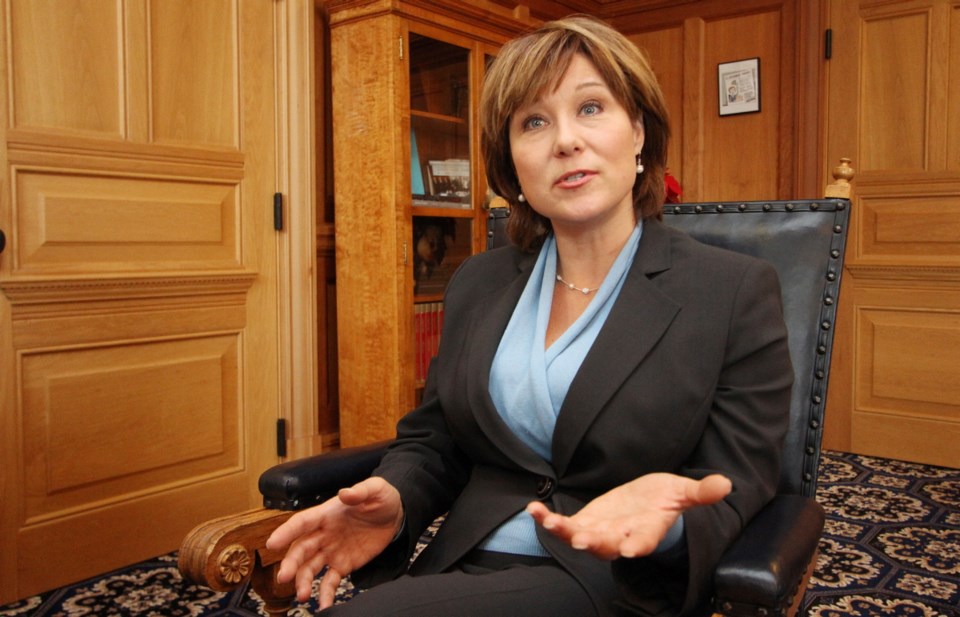Dirk Meissner
The 91ԭ�� Press
��
Premier Christy Clark says her government’s plan to export liquefied natural gas to Asia is British Columbia’s economic equivalent to Alberta’s oilsands.
In an interview with the 91ԭ�� Press, Clark said B.C.’s LNG development ambitions will transform the economy, but the province must act quickly before the opportunity evaporates like gas into the atmosphere.
Clark, who has spent the last year describing her “bold” and “audacious” plan to turn B.C. into Canada’s job-creation engine, said British Columbians will still be cashing in on the benefits of LNG exports 50 years from now.
“Think about it in these terms: What oil has been to Alberta since the 1970s-’80s is what LNG is going to be for British Columbia, nothing less than that,” said Clark.
“Energy output from LNG will likely be as big as the total energy output today from the oilsands,” she said.
Experts in the LNG industry do not completely agree with Clark’s Alberta oilsands comparison, but are on board in describing the opportunity as monumental and one that should be fast tracked.
“This is huge,” said Ron Loberec, Deloitte’s 91ԭ�� resources spokesman. “It’s a no-brainer. Australia is going to make tens of billions of dollars out of these gas contracts. You’ve got to say yes to something.”
Loberec, who is based in Calgary, said Clark’s statement about LNG in B.C. rivalling oilsands in Alberta is “arguing quantum, but I think it’s a significant opportunity.”
Recent Alberta government statistics indicate royalties from the oilsands were $3.7 billion in 2010-2011.
The 91ԭ�� Energy Research Institute reported Alberta can expect $350 billion in royalties and $122 billion in provincial and municipal tax revenue from the oilsands over the next 25 years.
About 151,000 Albertans were directly employed in the oil and gas extraction and mining sectors in 2011, about one of every 14 jobs in the province.
International LNG development expert Zoher Meratla, whose Whistler company, CDS Research Ltd., has been in the LNG industry for 35 years, said Clark is not off base when she puts B.C.’s LNG opportunities on the same scale as Alberta’s oilsands.
“Economically, it’s similar to the oilsands,” said Meratla, who has worked on LNG projects in Australia, Africa, the Middle East, Russia and Norway. “It’s exactly in the same league, and we have the advantage that we don’t carry the environmental burden.”
Clark’s jobs plan, introduced in September 2011, said global trade in LNG — natural gas that is cooled to the point where it can be loaded onto tankers — doubled over the last decade and is expected to increase by another 50 per cent by 2020.
She said her government is committed to working with the gas industry to build a pipeline from the province’s northeast natural gas fields to an LNG terminal in northwest B.C. near Kitimat, where the product will be shipped to Asia.
Currently, natural gas prices in North America are at historic lows and Asian prices are more than three times higher than those in B.C.
Clark said the Liberals have their sights set on opening three LNG operations in B.C. by 2020, with the first up and running by 2015.
In October 2011, the National Energy Board granted Kitimat LNG a 20-year export licence to serve international markets.
Kitimat LNG partners include Apache Corp., EOG Resources Inc., and Encana Corp. Kitimat’s Haisla Nation is also involved in the project, which includes the terminal site on their traditional lands.
Clark’s Liberals say the completed LNG plants will create up to 1,000 direct jobs and up to 9,000 jobs during the eight-year construction phase.
She said the projects are set to generate $20 billion in direct investment and the LNG revenues could contribute up to $2 billion annually in provincial revenues.



